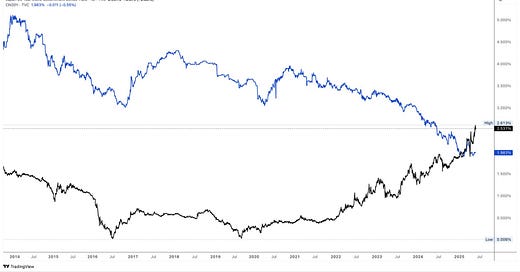Robolution: Japan’s Answer to Demographic Decline and Economic Revival
At the heart of Japan’s resurgence is a “Robolution”—a boom in industrial robots—alongside leadership in energy efficiency (including pioneering modular nuclear reactors), supply chain ....
Sometimes the most profound stories in economics aren’t about what’s breaking, but about what’s being built in the cracks. In May 2025, two of the world’s economic giants—China and Japan—are moving in opposite directions, and the contrast is revealing a truth about adaptation that investors can’t afford to ignore. While China cools into deflation, Japan is heating up with inflation, growth, and a quiet revolution in innovation. At the heart of Japan’s resurgence is a “Robolution”—a boom in industrial robots—alongside leadership in energy efficiency (including pioneering modular nuclear reactors), supply chain reconfiguration, biotech, and anti-aging technology. And it’s all happening against the backdrop of one of the world’s toughest demographic challenges.
Let’s set the stage. China, the growth engine of the past few decades, is hitting a wall. Its 20-year government bond yields have dropped from 3.5% in 2014 to 1.983%.
That’s deflation talking—weak demand, a slowing economy, and a ripple effect that cools global trade and commodity prices. When China sneezes, the world catches a cold, and right now, it’s feeling a bit frosty.
Meanwhile, Japan is rewriting its story. After decades of stagnation, its 20-year bond yields have climbed from 0.006% to 2.613%, signaling inflation and growth. The Nikkei is hitting new highs, snapping a bear market that’s lingered since the 1990s. This isn’t just a market rally; it’s a sign of a nation finding its footing in a changing world. But what makes Japan’s story so compelling isn’t just the numbers—it’s how it’s turning its biggest challenges into opportunities.
Japan’s demographic crisis is no secret. With an average age of 48 and a shrinking population, the country faces a shrinking workforce and rising healthcare costs. Demographic growth isn’t just a problem; it’s a looming cliff. But Japan didn’t sit idly by. Instead, it sparked a “Robolution”—a boom in industrial robots that’s reshaping its economy. Companies like Fanuc and Yaskawa are leading the charge, making Japan the global leader in robotics. With fewer workers, Japan has leaned on automation to keep factories running, boost productivity, and stay competitive. In 2023, Japan accounted for nearly half of the world’s industrial robot installations, a trend that’s only accelerated into 2025. This isn’t just about replacing humans—it’s about reimagining work in a way that keeps an aging society vibrant.
Energy efficiency is another arena where Japan is setting a global standard, driven by necessity and innovation. After the Fukushima disaster in 2011, Japan had to rethink its energy future without abundant natural resources. The result is a multifaceted push into energy-efficient technologies, from green tech like hydrogen fuel cells and next-gen batteries to cutting-edge modular nuclear reactors. Toyota, for instance, isn’t just building electric cars; it’s pioneering energy storage solutions that could redefine sustainable power. But Japan’s energy story goes beyond green tech—it’s also about maximizing efficiency through nuclear innovation. Hitachi, through its partnership with GE Hitachi Nuclear Energy, is at the forefront here. They’re developing the BWRX-300, a small modular reactor (SMR) designed for safety and economic performance. This 300-MWe reactor uses passive safety systems and natural circulation, slashing complexity and costs compared to traditional nuclear plants.
Hitachi’s vision includes reducing radioactive waste toxicity and initial investment risk, making nuclear power more viable for a carbon-neutral future. The BWRX-300 is already making waves globally—Canada approved its deployment at Ontario’s Darlington site in May 2025, aiming for operation by 2029, while Estonia, Poland, and the U.S. are also pursuing it. Hitachi is also working on the PRISM, a sodium-cooled fast reactor, and the RBWR, a light-water-cooled fast reactor, both of which promise enhanced efficiency and safety. These modular reactors aren’t just about power generation—they’re about energy efficiency at scale, offering flexible, low-carbon solutions that can integrate with renewables and meet modern grid demands.
Global supply chains are another area where Japan excels. As geopolitical tensions with China push companies to diversify, Japan’s expertise in high-precision manufacturing—like semiconductors from Tokyo Electron—makes it a linchpin. The world needs chips, and Japan is delivering, reconfiguring supply chains in its favor.
Then there’s biotechnology and anti-aging technology, where Japan’s demographic challenge becomes a global opportunity. With one of the highest life expectancies—over 84 years—Japan is investing in regenerative medicine and longevity science. Companies like Eisai and Takeda Pharmaceutical are working to slow aging, keeping people healthier for longer. The global anti-aging market is projected to hit $93 billion by 2027, and Japan is poised to lead.
What ties all this together is Japan’s ability to adapt. For 30 years, it was the poster child for stagnation—a cautionary tale of a burst bubble. But while the world looked away, Japan was learning. Now, as China cools, Japan is heating up, and its mix of inflation, growth, and innovation makes it a magnet for capital. The Robolution, energy efficiency through green tech and modular nuclear reactors, supply chain shifts, biotech, and anti-aging tech aren’t just trends—they’re proof that the best opportunities come from solving the hardest problems.
History teaches us that markets reward those who adapt, not those who complain. In 2025, while China wrestles with deflation, Japan is showing the world how to turn a demographic crisis into a springboard for growth. From robots keeping factories alive to nuclear reactors like the BWRX-300 powering a cleaner future, Japan’s story is one of resilience. It’s a reminder that the future doesn’t belong to the biggest economies—it belongs to the ones that can evolve. And right now, Japan is evolving faster than most.
Thanks for reading,
Guillermo Valencia A
Co-founder MacroWise







Ver a Japón levantarse con “Robolution” es lo que tiene que pasar en el país de Mazinger Z …. Qué maravilla!
GDP is measure in Joules! Thanks Guillo!